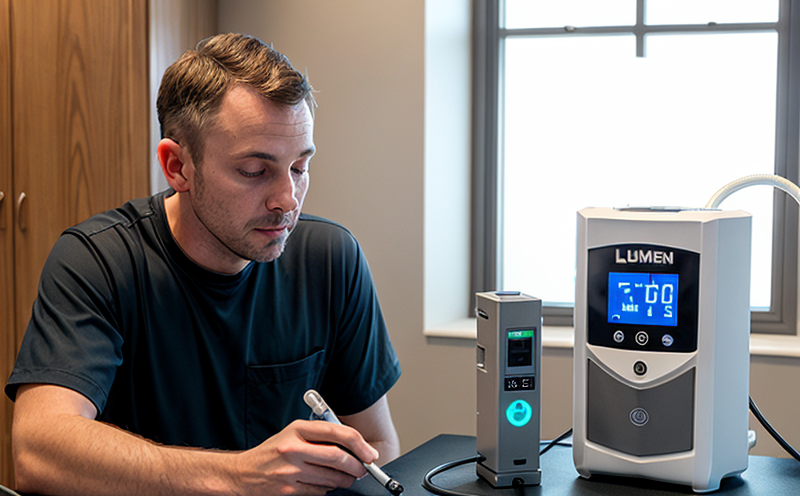IEC 62722 2 1 Lumen Maintenance Testing of LED Luminaires
The IEC (International Electrotechnical Commission) 62722-2-1 standard is a crucial document for the testing and evaluation of luminaires with respect to lumen maintenance. This standard ensures that LED luminaires maintain their initial light output over time, which is essential for maintaining energy efficiency and overall performance.
The primary purpose of this test is to determine whether an LED luminaire can retain its specified percentage of the initial light output after a certain period. The lumen maintenance test is critical because it directly impacts the efficacy and longevity of lighting systems in various applications, from residential to commercial settings.
During testing, luminaires are subjected to accelerated aging conditions that simulate real-world operating environments. These conditions may include temperature cycling, humidity exposure, and other environmental stressors. The test evaluates how well the luminaire retains its light output under these challenging conditions over a defined period.
The standard specifies detailed procedures for conducting lumen maintenance tests on LED luminaires. It provides clear guidelines on specimen preparation, testing setup, data recording, and analysis to ensure consistent and reliable results across different laboratories. Compliance with this standard not only ensures product quality but also supports regulatory compliance in various jurisdictions.
The importance of lumen maintenance cannot be overstated, especially for LED luminaires where the rate of light output decrease is a significant factor affecting system performance. By adhering to IEC 62722-2-1 standards, manufacturers can demonstrate their commitment to producing high-quality products that meet both technical and regulatory requirements.
The test results provide valuable insights into the expected lifespan of LED luminaires under real-world conditions. This information is invaluable for quality managers, compliance officers, R&D engineers, and procurement teams who rely on accurate data to make informed decisions about product development and purchasing.
Why It Matters
The lumen maintenance test of LED luminaires is essential for several reasons. Firstly, it helps ensure that the luminaire performs consistently over its lifetime, which is critical for energy efficiency and cost savings. Secondly, compliance with this standard enhances brand reputation by demonstrating a commitment to quality and reliability.
From an environmental perspective, maintaining high lumen output ensures that lighting systems continue to meet their intended performance criteria, thus reducing the need for frequent replacements and minimizing waste. Additionally, it supports regulatory compliance in regions where such standards are mandated.
The test also plays a crucial role in product development and quality assurance. By identifying potential issues early on, manufacturers can address them before products reach the market, leading to improved product reliability and customer satisfaction. This not only boosts sales but also fosters long-term relationships with clients.
In summary, lumen maintenance testing is vital for maintaining energy efficiency, ensuring compliance with international standards, supporting environmental sustainability, and enhancing overall product quality and performance.
Benefits
- Enhanced Energy Efficiency: Ensures that LED luminaires maintain their light output over time, thereby preserving energy savings.
- Improved Reliability: Identifies potential issues early in the product lifecycle, leading to more reliable and durable products.
- Regulatory Compliance: Helps manufacturers meet international standards, ensuring compliance with local regulations.
- Sustained Performance: Provides accurate data on lumen maintenance over time, enabling better-informed decisions about product performance.
- Environmental Impact Reduction: By maintaining high lumen output, the need for frequent replacements is reduced, minimizing waste and environmental impact.
- Better Customer Satisfaction: Ensures consistent quality and reliability, leading to higher customer satisfaction and loyalty.
Quality and Reliability Assurance
The IEC 62722-2-1 standard plays a pivotal role in the quality assurance process for LED luminaires. The testing procedure involves subjecting specimens to specific environmental conditions designed to simulate real-world usage scenarios. This includes temperature cycling, humidity exposure, and other stressors that can affect the performance of LED components.
The test setup typically involves placing the luminaire under controlled conditions for a specified duration. During this period, continuous monitoring of light output is conducted using high-precision photometers and data loggers. The results are then analyzed to determine if the luminaire maintains its initial lumen output within acceptable limits.
Accurate specimen preparation is critical to obtaining reliable test results. This includes ensuring that the luminaires are properly installed in a representative environment, free from any external factors that could influence the outcome. Compliance with this standard ensures consistent and repeatable results across different testing facilities, promoting trust and confidence among stakeholders.
The acceptance criteria for lumen maintenance tests are stringent and are based on international standards such as IEC 62722-2-1. These criteria specify the permissible limits of light output reduction over time, which serve as benchmarks for evaluating product performance. By adhering to these criteria, manufacturers can ensure that their products meet or exceed expectations in terms of quality and reliability.
In conclusion, lumen maintenance testing is an indispensable part of the quality assurance process for LED luminaires. It not only ensures compliance with international standards but also enhances overall product performance and customer satisfaction.





